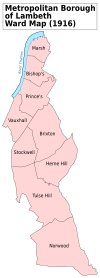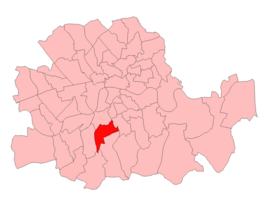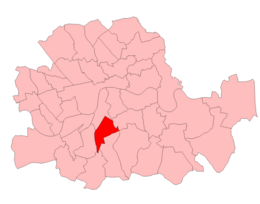Brixton (UK Parliament constituency) facts for kids
Quick facts for kids {{{Name}}}[[{{{Type}}} constituency]] |
|
|---|---|
| [[Image:{{{Map1}}}Constituency.svg|120px|]] [[Image:England{{{Map2}}}.svg|120px|]] |
|
| {{{Name}}} shown within [[{{{Entity}}}]], and {{{Entity}}} shown within England | |
| Created: | {{{Year}}} |
| MP: | {{{MP}}} |
| Party: | {{{Party}}} |
| Type: | House of Commons |
| County: | [[{{{County}}}]] |
| EP constituency: | [[{{{EP}}} (European Parliament constituency)|{{{EP}}}]] |
Brixton was an area in South London that used to have its own special representative in the UK Parliament. This area was called a "parliamentary constituency." From 1885 to 1974, people living in Brixton voted for one person to be their voice in the House of Commons, which is part of the Parliament of the United Kingdom. This person was called a Member of Parliament, or MP. They were chosen using a system called "first-past-the-post," where the candidate with the most votes wins.
Contents
History of Brixton's Parliament Seat
The Brixton constituency was first created for the general election in 1885. A general election is when people across the country vote for their MPs. This special voting area lasted for many years. It was eventually removed for the general election in February 1974. After that, most of the Brixton area became part of a new voting area called Lambeth Central.
Understanding Brixton's Boundaries
The borders of the Brixton voting area changed a few times over the years. These changes were made to make sure each MP represented a fair number of people.
Brixton's Early Borders (1885–1918)
The Brixton constituency was created when the larger Lambeth area was split into four smaller voting areas. This happened because of a law passed in 1885. The official name for the area was "Lambeth, Brixton Division." It included parts of the Lambeth parish, specifically:
- Parts of the Brixton and Stockwell areas, north of Acre Lane and Coldharbour Lane.
- Part of the Vauxhall area, east of Clapham Road.
Changes to Brixton's Borders (1918–1950)
In 1918, a new law changed how voting areas were drawn across the country. In London, these areas were updated to match the new "Metropolitan Boroughs" that had been set up in 1900. The Brixton constituency then included parts of the Metropolitan Borough of Lambeth:
- The entire Stockwell ward.
- A section of the Brixton ward.
- Part of the Herne Hill ward.
- A section of the Tulse Hill ward.
Final Border Changes for Brixton (1950–1974)
The last time Brixton's borders changed was in 1948. These new borders were used starting with the 1950 general election. Because the number of people in Lambeth had changed, the area was reduced from four voting constituencies to three. The new "Lambeth Brixton Borough Constituency" included four specific areas (called wards) of the metropolitan borough:
- The Angell, Stockwell, Town Hall, and Vassal wards of Lambeth.
In 1965, the local government in London was completely reorganized. The old metropolitan borough was replaced by the larger London Borough of Lambeth. However, these changes didn't affect the parliamentary voting areas until the general election in February 1974. At that point, the Brixton constituency was mostly replaced by the new Lambeth Central voting area.
Members of Parliament for Brixton
Here are the people who represented Brixton in the House of Commons:
| Election | Member | Party | |
|---|---|---|---|
| 1885 | Ernest Baggallay | Conservative | |
| 1887 by-election | Marquess of Carmarthen, later became The 10th Duke of Leeds in December 1895 | Conservative | |
| 1896 by-election | Evelyn Hubbard | Conservative | |
| 1900 by-election | Sir Robert Mowbray | Conservative | |
| 1906 | Joel Seaverns | Liberal | |
| 1910 | Davison Dalziel, later Baron Dalziel | Conservative | |
| 1923 | Frederick Joseph Laverack | Liberal | |
| 1924 | Davison Dalziel, later Baron Dalziel | Unionist | |
| 1927 by-election | Nigel Colman | Conservative | |
| 1945 | Marcus Lipton | Labour | |
| Feb 1974 | constituency abolished: see Lambeth Central | ||
Images for kids





